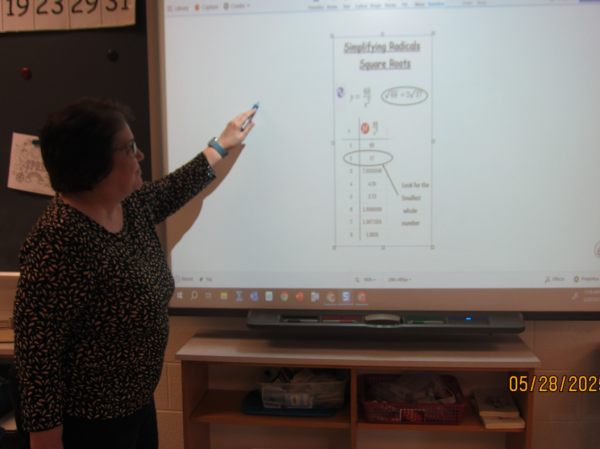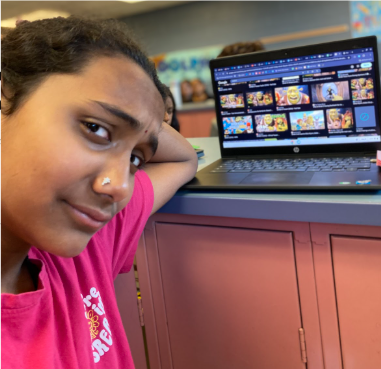Despite drawbacks, SOLs remain schools’ go-to choice for testing
Roman Moreno-Hines, an eighth-grader works outside on his laptop.
SOL season has arrived, and while new testing methods have been tried, teachers and state and federal officials have yet to find the perfect alternative to standardized testing.
“I am not a one size fits all teacher, and standardized testing is a one size fits all curriculum,” said Ms. Amy Allen, an English teacher on the Legacy team.
In recent years, some schools have begun to try alternatives to standardized testing such as stealth assessments and portfolio-based assessments.
Stealth assessments refer to the method of collecting a student’s responses to test questions throughout the year. This provides the results of the student over the course of a year or a semester.
Stealth testing avoids the stop-and-test idea and doesn’t give students the stress and pressure of standardized testing. Another plus is that it tracks the complete growth of a student over a longer period of time, giving more accurate information about their progress.
Portfolio-based assessments on the other hand don’t involve answering a set of questions. These assessments are not a form of a test, and allow students to use their creativity to show what they have learned.
Portfolio-based assessments refer to a project, about a certain topic or subject, that is completed by the student. A pro of this kind of examination is that it allows students to show their progress of learning through a more imaginative way.
RCMS was working on a pilot program for portfolio-based assessments in 2020 when schools shut down for Covid.
Still, what our school and county ends up doing is in the hands of the Virginia State Department of Education, and the state finds SOLs necessary.
Standardized tests help fulfill state and county requirements. Even though many students and teachers don’t like them, they prove to be necessary for the state and county education departments to better understand how students are learning. Results from these tests help education officials update curriculums to better support students.
These tests also provide teachers with a guide to better teach their students and get more information on their learning journey and show students how much they’ve grown.
Ms. Allen said the SOL tests give teachers a guide to better teach their students.
While there may be many flaws with the system of standardized testing in the minds of students, they help gather crucial information about a student’s progress and help to better support a student.
Years of testing
Students have been taking standardized tests since first grade. We started with the NNAT in first grade and COGAT in second grade determining whether or not a student is placed in AAP (Advanced Academics Program).
Middle school students are required to take many standardized tests this year in Math and English classes including:
- Reading Virginia Growth Assessments
- Math Virginia Growth Assessments
- NoRedInk Diagnostics
- Reading SOL
- Math SOL
- Reading Inventories
- Math Inventories
“The love of learning takes the backseat when we have so many tests,” Ms. Allen said.
Challenges of standardized testing
Many students have learning difficulties including dyslexia, ADHD, dyscalculia, dysgraphia, and dyspraxia, and those students may be at an extra disadvantage when taking standardized tests.
A study conducted in New York in 2015 shows that only 5.7% of students with learning disabilities exceeded or met the reading proficiency standard, while 36.6% of general students met the standards.
Soph Lamy, an eighth-grader on the Yellow Jackets team, said that when taking the NNAT and COGAT, she had trouble taking the test because of her dyslexia. This can affect students’ placement in school programs, which raises concerns about fairness and equity.
“I never enjoyed the idea of one test for every person,” Ms. Allen says.
Standardized testing puts a lot of pressure on students and causes them to get stressed out. This can affect how a student learns, and can affect how they perform in school and on tests.
Sarayu Kannam, a seventh-grader on the Legacy team said, “I don’t think they [standardized tests] support my learning.”
Some find it necessary to prepare for standardized tests while others don’t take too much stress over them. Some students wing it and do their best in the moment of the test.
Ms. Allen gives her students test-taking strategies to help them during any test. These strategies can be used in any diagnostics, SOLs, and even in curriculum based tests.
“We are instructed as teachers to differentiate material, lessons, and exams,” Ms. Allen said, “so why is there only one test for everyone, when it’s not like that in my classroom?”







